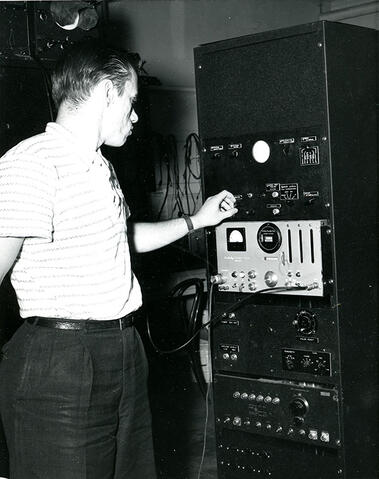
Title and statement of responsibility area
Titel
Institute of Space and Atmospheric Studies
Algemene aanduiding van het materiaal
- Graphic material
Parallelle titel
Overige titelinformatie
Title statements of responsibility
Titel aantekeningen
Beschrijvingsniveau
Stuk
archiefbewaarplaats
referentie code
Editie
Editie
Edition statement of responsibility
Class of material specific details area
Statement of scale (cartographic)
Statement of projection (cartographic)
Statement of coordinates (cartographic)
Statement of scale (architectural)
Issuing jurisdiction and denomination (philatelic)
Datering archiefvorming
Datum(s)
-
[between 1963 and 1968] (Vervaardig)
Fysieke beschrijving
Fysieke beschrijving
1 photograph : b&w ; 12.5 x 10 cm
Publisher's series area
Title proper of publisher's series
Parallel titles of publisher's series
Other title information of publisher's series
Statement of responsibility relating to publisher's series
Numbering within publisher's series
Note on publisher's series
Archivistische beschrijving
Naam van de archiefvormer
Geschiedenis beheer
Bereik en inhoud
[Rudy Wiens] stands beside a large piece of electrical equipment in a lab.
Bio/Historical Note: The Institute of Space and Atmospheric Studies (ISAS) was formed in 1956 to study the aurora (northern lights), the related 'disturbances' in the upper atmosphere and ionosphere, and the effects of solar activity upon climate. On 11 July 1967, the University's Institute of Space and Atmospheric Studies in co-operation with Bristol Aero-Space Industries Ltd. of Winnipeg sent up two Black Brant 3 rockets from the Churchill Research Range. The launchings marked the third and fourth in a series of experiments to better understand weather patterns by studying the photochemistry of the atmosphere. Each rocket rose approximately 100 km into the atmosphere. The clamshell nose cones separated in flight to expose a light measuring device called a photometer. All measurements were “telemetered” to the ground and no attempt was made to recover the scientific instruments. Both payloads, weighing approximately 80 kilograms, were built and tested in the workshops of the institute on campus and then sent to Winnipeg for further testing and incorporation into the nose cones. Bristol Aero-Space supplied the rocket engineering under a contract with the National Research Council. The institute continues to expand the world's knowledge and understanding of how the sun and the earth interact; and trained more than 200 scientists and engineers in a wide range of technical and scientific areas. ISAS developed observing systems for space and atmospheric sciences, ground based optical and radar instruments, and satellite systems, remote sensing technology, and knowledge of STP processes are a vital resource for "Canadian Space Science" and couples powerfully into high-technology industries.
Aantekeningen
Materiële staat
Directe bron van verwerving
Ordening
Taal van het materiaal
Schrift van het materiaal
Plaats van originelen
Beschikbaarheid in andere opslagformaten
Restrictions on access
There are no restrictions on access.
Termen voor gebruik, reproductie en publicatie.
Photographer: Unknown
Copyright holder: Unknown
Other terms: Responsibility regarding questions of copyright that may arise in the use of any images is assumed by the researcher.

